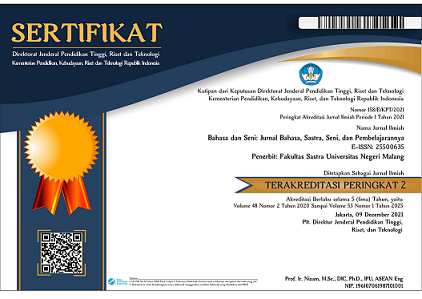TRANSFORMASI SENDRATARI LEGENDA KAMANDAKA DALAM UPAYA MELESTARIKAN KEBUDAYAAN BANYUMAS
Abstract
Keyword: Legend Kamandaka; Transformation; Local wisdom; Ballet dance
Full Text:
PDFReferences
Ahimsa-Putra, Heddy Shri. 2001. Struktuturalisme Levi-Strauss Mitos dan Karya Sastra. Yogyakarta:Galang Press.
Astra, I Gde Semadi. 2004. Revitalisasi Kearifan Lokal dalam Memperkokoh Jati Diri Bangsa di Era Global” dalam I Wayan Ardika dan Darma Putra (ed). Politik Kebudayaan dan Identitas Etnik. Denpasar: Fakultas Sastra Universitas Udayana dan Balimangsi Press.
Brata, Ida Bagus. 2016. Kearifan Budaya Lokal Perekat Identitas Bangsa. Bakti Saraswati. Vol 5:11.
Chamamah, S. 1994. Penelitian sastra (teori dan metode). Yogyakarta:Elmatera.
Danandjaja, J. 2002. Folklor Indonesia. Jakarta: Pustaka Pelajar.
Hersapandi. 2017. Sendratari Rara Jonggrang dalam Perspektif Koreografis dan Pariwisata.Panggung Seni dan Budaya. Vol 27:178.
Nazir, M. 1983. Metode penelitian. Jakarta: Ghalia Indonesia.
Ryolita, Widya Putri. 2018. Variasi Legenda Kamandaka Berdasarkan Transmisi Masyarakat Pendukung. Haluan Sastra UNS. Vol 2: 239.
Sadewa, I Ketut. 2014. Trandformasi Sastra Lisan ke Dalam Seni Pertunjukan di Bali: Perspektif Pendidikan. Humaniora. Vol 26: 65-73.
Santoso, Puji. 2015. Metodologi Penelitian Sastra: Paradigma, Proposal, Pelaporan, dan Penerapan. Yogyakarta: Azzagrafika
Suwignyo, Heri. 2013. Makna Kearifan Budaya Jawa Dalam Puisi Pariksit, Telinga, Dongeng Sebelum Tidur, dan Asmarandana. Bahasa dan Seni Universitas Negeri Malang. Vol 41:181-189.
Wildan. 2013. Kearifan Lokan dalam Novel Seulusoh Karya D. Kemalawati. Jurnal Bahasa dan Seni. Vol 41:30-38.
Refbacks
- There are currently no refbacks.

This work is licensed under a Creative Commons Attribution 4.0 International License.

Dear Sir/Madam
We appreciate your continued confidence and trust in Bahasa dan Seni: Jurnal Bahasa, Sastra, Seni, dan Pengajarannya (JBS). In order to enhance the service, readability, and quality of JBS publications, we will be transitioning to a new website, https://citeus.um.ac.id/jbs, in collaboration with Digital Commons (Elsevier) starting in July 2024.
Sincerely
Yusuf Hanafi
(Editor in chief)















2.png)